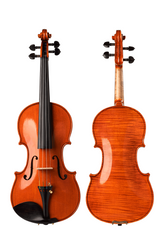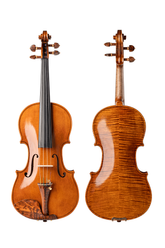Simple Adjustments to the Violin's Sound Post and Bridge to Improve Tone
In a symphony orchestra, the violin is among the most numerous and expressive instruments, playing a leading role in performances. Some people refer to the violin as the "Queen of Instruments" and say it was invented by God. This shows how highly regarded and perfect the violin is in people's minds.

However, not every violin produces a beautiful and ideal sound, even if they all look equally exquisite. The fact is that violins that appear similar can sound quite different, even drastically so. Unexpectedly, changing a single component, such as the sound post or bridge, or even readjusting the same part, can significantly alter the sound.
This demonstrates that the tone of a violin can indeed be adjusted. One effective and simple way to do this is by tweaking these seemingly insignificant small components.
A violin with a beautiful and pleasing tone should have a bright and clear sound on the E string, a soft and mellow tone on the A string, a slightly tense sound on the D string, and a deep, majestic, and solid tone on the G string. Such a violin can be considered a qualified professional instrument.
Although the violins played by members of a symphony orchestra are generally of good quality, upon closer listening, some of them may not have ideal tonal qualities. The reasons for this are complex and involve many factors, but it is often related to the improper fitting of certain parts.
Violin Sound Post
Let's start by discussing the sound post. The sound post is a small and seemingly insignificant part compared to the entire violin, but it has a significant impact on the instrument's tone. Even the best violin can sound dull and lifeless if it does not have a properly fitted sound post. This is why some people refer to the sound post as the "soul post."
The sound post is made of spruce wood. A sound post typically has five or six growth rings, which is generally considered ideal. But does older wood always make for a better sound post? In my experience, when using two sound posts made from wood of different ages but with identical specifications, and fitting them in the same position of the same violin, the difference in tonal adjustment is minimal. I believe that the sound post's effect on a violin's tone mainly depends on its correct length, thickness, position, and distance from the bridge.
The length of the sound post is determined by the violin's structure. A violin with a higher body requires a longer sound post, and vice versa. Regardless of its length, the two ends of the sound post must fit snugly against the inner surfaces of the top and back plates.
Generally, without the strings being fully tightened, the sound post should stand in the correct position inside the violin without falling over. This is the usual standard. If the violin's sound is dull and unresponsive, replacing the sound post with a slightly longer one that fits more tightly can help make the sound more open and bright.
If the sound is too bright, noisy, or even harsh, lacking in warmth, the sound post can be adjusted to be slightly looser than the standard, reducing the tension between the sound post and the top plate. This can help eliminate some noise and soften the tone.
The tone can also be adjusted by changing the thickness of the sound post. The diameter of the sound post generally ranges between 5.5mm and 6.5mm. A thicker sound post can dampen some vibrations, resulting in a more solid tone, but it may also cause the resonance to become coarser and less refined. Conversely, a thinner sound post has the opposite effect. The choice depends on the desired result. During adjustment, it's best not to exceed the usual range for the sound post's thickness, or it might have the opposite effect.
The positioning of the sound post is also important. Typically, the sound post is placed inside the violin, about 2mm to 4mm away from the lower right corner of the bridge. Adjustments can be made within this distance range. If the violin's sound is noisy, the sound post can be moved slightly downward, further away from the bridge, and shortened, which can greatly improve the sound. If the sound is nasal or muffled, moving the sound post slightly upward, closer to the bridge, can make the tone more open and bright.
It's important to note that when adjusting the sound post, the strings should be slightly loosened to avoid damaging the violin's inner plates. Once the sound post is adjusted to the ideal position, it should remain in use for a long time, even for years, and should not be changed easily. This is because adjusting a sound post to the perfect position is not easy, and frequently changing it can also harm the violin.
In short, adjusting the sound post is indeed crucial in altering the tone of a violin.
When you have not yet adjusted the sound post to its most ideal and precise state, do not rush to judge the quality of your violin's tone. If all the violinists in a symphony orchestra paid attention to this small component, ensuring that each violin's sound post was in its optimal position, the overall tone of the violins during performances would likely be more satisfactory and ideal.
Violin Bridge
Now let's talk about the bridge. The bridge is another small component that significantly affects a violin's tone, so adjusting the bridge is just as important as adjusting the sound post.
The bridge is usually made from aged maple. Some believe that the more expensive or branded a bridge is, the better it will be. From my experience, while a prestigious bridge may offer stable quality, it may not be suitable for every violin. Different violins with different tonal qualities require different bridges. From the perspective of bridge adjustment, as long as the right bridge is chosen to match a specific violin, it can usually produce good sound. For a violin that sounds dull or unresponsive, the feet of the bridge should be thinned, and the bridge itself should be relatively thin, with the wood not being too hard. The bridge should also be slightly smaller than normal. This could improve the sound. Additionally, the fingerboard height should be checked. If it is too high, it can be adjusted to the standard height, as a higher bridge can easily cause the sound to be muffled. Of course, lowering the fingerboard is not easy and comes with certain risks, so it should be done with great care.
If the violin's sound is too bright or noisy, a harder wood or a slightly larger bridge may be selected. The feet of the bridge should not be too thin, and the bridge should be slightly thicker. This can help reduce excessive brightness in the tone. Of course, the height and thickness of the bridge should be appropriate and should not exceed the normal range by more than 1mm. Adjusting the bridge requires careful work and should be done gradually.
Additionally, the bridge should be regularly checked for warping. If it bends forward, it should be corrected backward, and if it bends backward, it should be adjusted forward. The bridge should generally be kept at a 90-degree angle to the top plate. Also, the grooves where the strings rest on the bridge should not be too deep, as this can hinder sound transmission.
Conclusion
Of course, adjusting the components of a violin cannot solve all tonal issues. A good tone relies on the finely crafted body of the violin as a resonating chamber. However, ensuring that all the components are properly adjusted and well-matched is also very important.





